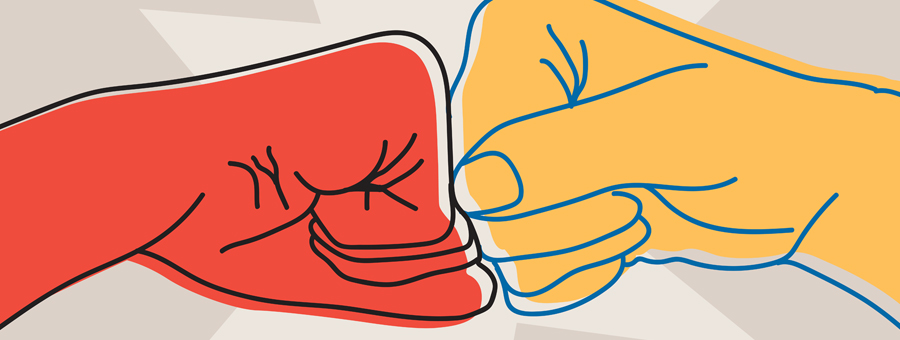In children’s hospitals, resilience is needed more than ever. Even before the pandemic, burnout had reached crisis levels among the U.S. health care workforce, according to the National Academy of Medicine. Previous efforts to curb burnout and build resilience led to organizations developing workplace initiatives in support of employee wellness. While these programs have made some progress, they primarily focus on individuals, which is only one factor in the problem of burnout.
Workplace well-being has three levels: the individual, with particular mindsets, response habits and demographic risk factors; the team, which includes factors like autonomy, support and recognition; and the organization, which looks at factors like staffing, performance measurements and hospital-wide policies.
Resilience is best achieved by focusing on all three levels rather than only on the individual. As Christina Maslach, Ph.D., one of the godmothers of burnout research, says: “Imagine investigating the personality of cucumbers to discover why they’d turned into sour pickles without analyzing the vinegar barrels in which they had been submerged.” Like vinegar, the environment at the organizational and team levels influences and shapes individuals’ experience of burnout and resilience.
The power of teams
Although changes at the organizational level are crucial, they take consistent leadership, significant resources and years of effort to implement—especially at children’s hospitals that often have thousands of employees across multiple campuses with varying schedules and different areas of focus. Change at a team level, however, can help foster resilience at a pace more achievable in the short term.
Teams are the functional group people interact with most frequently and rely on most heavily. Teams are the biggest predictor of churn—75% of employees state they left a job because of a team or direct manager. Teams set the cultural norms—as social creatures, humans are hardwired to read norms off those in their close communities. Structurally, teams are more agile. They can implement changes quickly, make decisions without approvals, and experiment with initiatives.
Teams know one another well, so they can recognize indicators of burnout, which occurs on a spectrum. The early parts of the spectrum are difficult to self-identify: excessive drive, pushing to work harder and longer, neglecting personal needs—all of which can simply look like a strong commitment to the job. If a teammate notices a colleague starting to withdraw, neglect personal care or change behavior, they can catch burnout upstream before it gets worse.
Four pillars of team health
There are four pillars of sustainable resilience that focus on cultivating change at the team level. They can serve as a guide for implementing and evaluating practices within teams structurally and culturally.
1 | Awareness
Resilient teams are aware of each person’s needs and triggers, including their own. They know how each person copes with stress and what motivates them. Are they driven by inspirational causes or by relationships? Do they internalize stress or externalize? Knowing this about teammates gives insight into how to interact with them, whether as a manager or colleague, to minimize stressors and maximize motivators—ultimately leading to higher resilience and less burnout.
Resilient teams understand one another’s sense of purpose and how it relates to each member. When the purpose is not being fulfilled, the team has a port in the storm, a work family to talk to. That puts people in a different response mode than if they are navigating by themselves.
Resilient teams know one another’s collective and individual values. No one can assume their values or how those values are expressed are going to be the same as a teammate’s.
Take action: Teams need structured ways to communicate about these things. In a hospital setting, it can be difficult to make time for this. Here is one simple exercise to get the backstory, values and purpose of your team members: Have each person meet with another teammate and tell their life story in thirds, spending three minutes on each part. Through the story, teammates will hear values implicit in the story, share them with the storyteller, and have the storyteller react. You can accomplish this in a half hour with one partner.
2 | Autonomy
In resilient teams, each member has input on priorities, autonomy in organizing time, and a balance of support and flexibility to make the right decisions and execute their tasks. The appropriate balance for a given team or employee will depend on the person’s personal preferences and seniority—some people require more autonomy to feel happy in their jobs and some are limited by their rank.
The amount of autonomy also depends on the person’s role. Some roles provide or even require different latitudes of decision-making and process flexibility. An intensive care clinical team will have a very different set of constraints than an administrative team. In the clinical setting, there is less flexibility in terms of when or where to work than there is with an administrative team, but clinicians can be given leeway in other areas such as process improvement.
When people use their autonomy to achieve something, it’s important to recognize it. Clinicians and administrators have reported they want recognition for their work. When they don’t receive that, it contributes to burnout.
Take action: Although there are constraints, leaders should look for ways to support decision-making in every role, even in small ways. When assigning tasks or projects, allow employees the freedom to develop their own approach. Make it a conversation rather than a command, which is important for a sense of control.
3 | Structured rejuvenation
Resilient teams are thoughtful about planning and structuring rest. They honor individual and team guardrails that separate work and personal life. And they are thoughtful about how work is distributed across a team, especially in aligning with the need for intermediate respite.
Creating policies and rules is essential, and team leaders need to be aware of how they are valuing rest culturally. Are they making sure to use their personal and vacation days? Are they regularly encouraging staff to take uninterrupted breaks during shifts? Are they respecting established boundaries?
Structured rest is one of the most challenging pillars, especially with staff shortages in health care. If staffing issues prevent adequate rest during certain periods, leaders need to understand the risk and articulate it, so the blame doesn’t fall on individuals. And then the question is, what are they doing after that period to ensure rest for the team rather than moving immediately to the next deadline?
Take action: Rejuvenation is also about understanding what energizes each person at work, which varies. Leaders should consider what changes can be made at a team level to ensure members are doing what energizes them, such as swapping duties that may be outside typical roles. For example, a nurse who prefers administrative tasks can swap some tasks with a nurse who prefers physicals tasks.
4 | Community
Resilient teams foster open collaboration and communication. Teammates do better when they understand how each person’s work fits in with the rest of the team’s, leading to a clear sense of contribution to a larger mission or goal.
It is essential for people to have at least one confidant on the job; someone they can be unfiltered with and get support from. Research overwhelmingly shows that if a person has just one workplace friend, retention and engagement skyrocket. Teams should facilitate opportunities for relationships, especially for new hires.
In addition to relationships, resilient teams have spaces for robust psychological safety and belonging. This means people can share their experience and observations about their environment without undermining themselves or adding additional friction. An essential part of achieving that is through model leadership. Leaders can start the dialogue and build trust. Meaningful conversations or input from people across a team won’t happen if they don’t view their leaders as allies. When leaders share their own struggles, it signals to the team that it is safe.
Finally, resilient communities are bolstered by compassion. In compassionate teams, people hear and trust one another, which results in greater well-being and satisfaction. It even affects the most practical areas of work, such as workload management, because the team members support each other.
Take action: As a leader, make intentional time to express doubts, struggles, and mistakes to teammates. Maybe this looks like a weekly meeting of sharing, or maybe it occurs informally. Frame it as a personal struggle, not as complaining or blaming.
Commit where it counts
The challenge of hospitals is to move beyond burnout initiatives aimed at individuals and focus on cultivating resilience through teams. This requires commitment to real initiatives driven by real data and designed around the four pillars of resilient teams.




